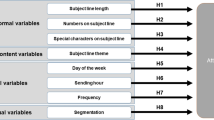Abstract
Most marketing managers know intuitively that once a customer delays a purchase decision, the potential is high that the purchase may be put off indefinitely. In response, marketing managers usually set ‘deadlines’ or time limits for how long an offer is available. However, research has shown that, while time limits can help motivate customers to buy now rather than later (or not at all), time limits that are over/under restrictive may actually hurt response more than help. We consider two opposing forces of time, namely awareness and urgency. Longer time limits allow for greater awareness of an offer, which, everything else being equal, should lead to a larger response. At the same time, longer time limits also reduce the urgency of an offer leading consumers to delay their purchase (perhaps) indefinitely and thus, everything else being equal, lead to a lower response. Using decision calculus, we model the optimal time limit for promotional offers and demonstrate its use in an email marketing application. Email marketing has emerged as a profitable tool for companies like Amazon and JCrew who regularly use email to communicate promotional offers to their customers because of its low cost to implement and its relatively high response rates. This research contributes to the field by providing marketing managers a methodology for determining superior choices for time limit in promotional offers.



Similar content being viewed by others
References
Amir O (2001). Closure on-line: The effect of time pressure and exploding discounts on purchase decisions. Paper presented at the Annual Conference of the Association for Consumer Research Austin, TX.
Sinha I, Rajan C and Srinivasan SS (1999). Consumers evaluation of price amd promotional restrictions—a public policy perspective. J Public Policy Market 18: 37–51.
The eMail Marketing Report: Volume 1, 2002 eMarketer, 821 Broadway New York, NY 10003 http://www.emarketer.com.
Hoffman DL and Novak TP (2000). How to acquire customers on the web. Harvard Business Rev May–June: 179–188.
Pew Internet & American Life Project (2001). More online, doing more. Available at http://www.pewinternet.org/.
Bawa K and Shoemaker RW (1987). The Coupon-prone consumer: some findings based on purchase behavior across product classes. J Market 51: 99–110.
Narasimhan C (1984). A price discrimination theory of coupons. Market Sci 3: 128–147.
Malhotra NK, Peterson M and Bardi Kleiser S (1999). Marketing research: a state of the art review and directions. J Acad Market Sci 27: 160–183.
Blattberg RC and Neslin SA (1990). Sales Promotions: Concepts, Methods, and Strategies. Prentice-Hall: New Jersey.
Inman JJ, Peter AC and Raghubir P (1997). Framing the deal: the role of restrictions in accentuating the deal value. J Consumer Res 24: 68–79.
Lynn M (1989). Scarcity effects on desirability: mediated by assumed expensiveness? J Econ Psychol 10: 257–274.
Cialdini RB (1993). Influence: the Psychology of Persuasion. William Morrow: New York (Revised Edition).
Inman JJ and McAlister L (1994). Do coupon expiration dates affect consumer behavior? J Market Res 31: 423–428.
Simonson I (1992). The Influence of anticipating regret and responsibility on purchase decisions. J Consumer Res 19: 105–118.
Greanleaf EA and Lehmann DR (1995). Reasons for substantial delay in decision consumer making. Journal of Consumer Research 22: 186–199.
Dhar R and Nowlis SM (1999). The effect of time pressure on consumer choice deferral. J Consumer Res 25: 369–384.
Ariely D and Wertonbroch K (2002). Procrastination, deadlines, and performance: self-control by precommitment. Psychol Sci 13: 219–229.
Klein R (2001). Swift's push for tax holiday may hurt retailers. The Boston Globe November 20, p. 1.
Little JDC (1970). Models and managers: the concept of a decision calculus. Mngt Sci 18: 466–484.
Wierenga B and van Bruggen GH (1997). The integration of marketing problem-solving modes and marketing management support systems. J Market 61: 21–37.
Fudge WK and Lodish LM (1977). Evaluation of the effectiveness of a model based salesman's planning system by field experimentation: Part 2. Interfaces 8: 97–106.
Lodish LM, Curtis E, Ness M and Simpson MK (1988). Salesforce sizing and deployment using a decision calculus model at Syntex Laboratories. Interfaces 18: 5–20.
McIntyre SH (1982). An experimental study of the impact of judgment-based marketing models. Mngt Sci 28: 17–33.
van Bruggen GH, Smidts A and Wierenga B (2001). The powerful triangle of marketing data, managerial judgment, and marketing management support systems. EurJ Market 35: 796–814.
Tversky A and Kahneman D (1974). Judgment under uncertainty: heuristics and biases. Sci 185: 1124–1131.
Chakravarti D, Mitchell A and Staelin R (1978). Judgment based marketing decision models: an investigation of the decision calculus approach. Mngt Sci 25: 251–263.
Chakravarti D, Mitchell A and Staelin R (1981). Judgment based marketing decision models: problems and possible solutions. J Market 45: 13–23.
Blattberg RC and Deighton J (1996). Manage marketing by the customer equity. Harvard Bus Rev, 136–144.
Berger PD and Nasr-Bechwati N (2001). The allocation of promotion budget to maximize customer equity. OMEGA: Int J Mngt Sci 29: 49–61.
Fan SS and Berger PD (2001). The optimal allocation between acquisition and retention spending over multiple time periods. Int Quart J Market 1: 199–210.
Roberts ML and Berger PD (1999). Direct Marketing Management, 2nd edition. Prentice-Hall: Upper Saddle River, NJ.
Farley J (1964). An optimal plan for salesmen's compensation. J Market Res 1: 39–43.
Gupta S (1988). Impact of sales promotions on when, why, and how much to buy. J Market Res 25: 342–355.
Buzzell RD (1964). Mathematical Models and Marketing Management. Harvard University, Division of Research: Boston.
Little JDC and Lodish L (1969). A media planning calculus. Opns Res 17: 1–35.
Rangan V (1987). The channel design decision: a model and an application. Market Sci 6: 156–174.
Parfitt J and Collins B (1968). Use of consumer panels for brand share prediction. J Market Res 5: 131–146.
Author information
Authors and Affiliations
Corresponding author
Rights and permissions
About this article
Cite this article
Hanna, R., Berger, P. & Abendroth, L. Optimizing time limits in retail promotions: an email application. J Oper Res Soc 56, 15–24 (2005). https://doi.org/10.1057/palgrave.jors.2601804
Received:
Accepted:
Published:
Issue Date:
DOI: https://doi.org/10.1057/palgrave.jors.2601804




